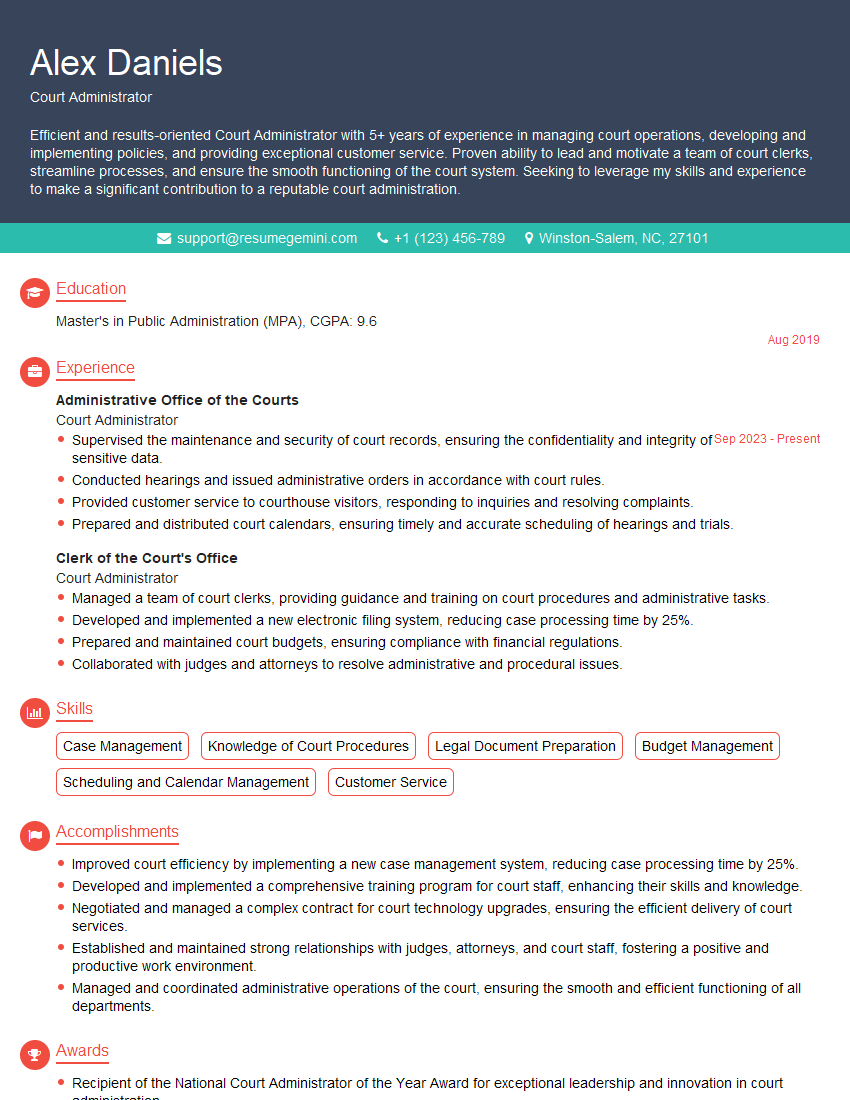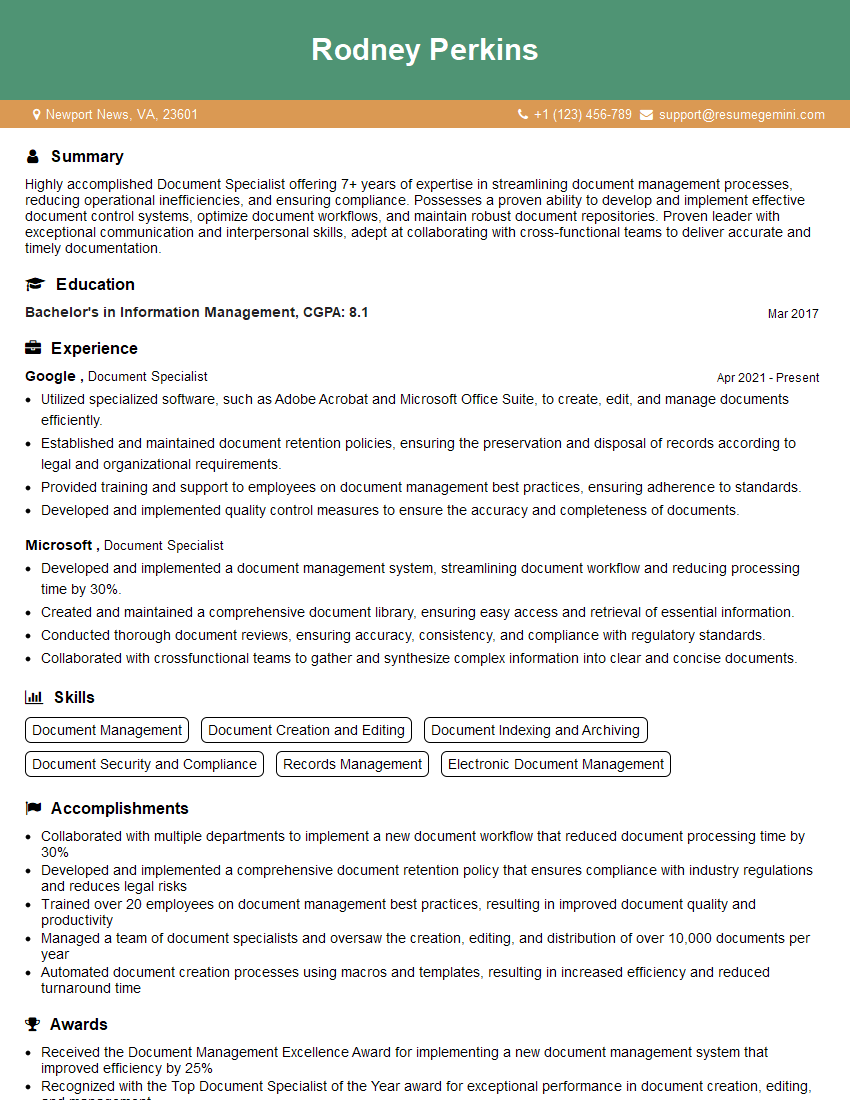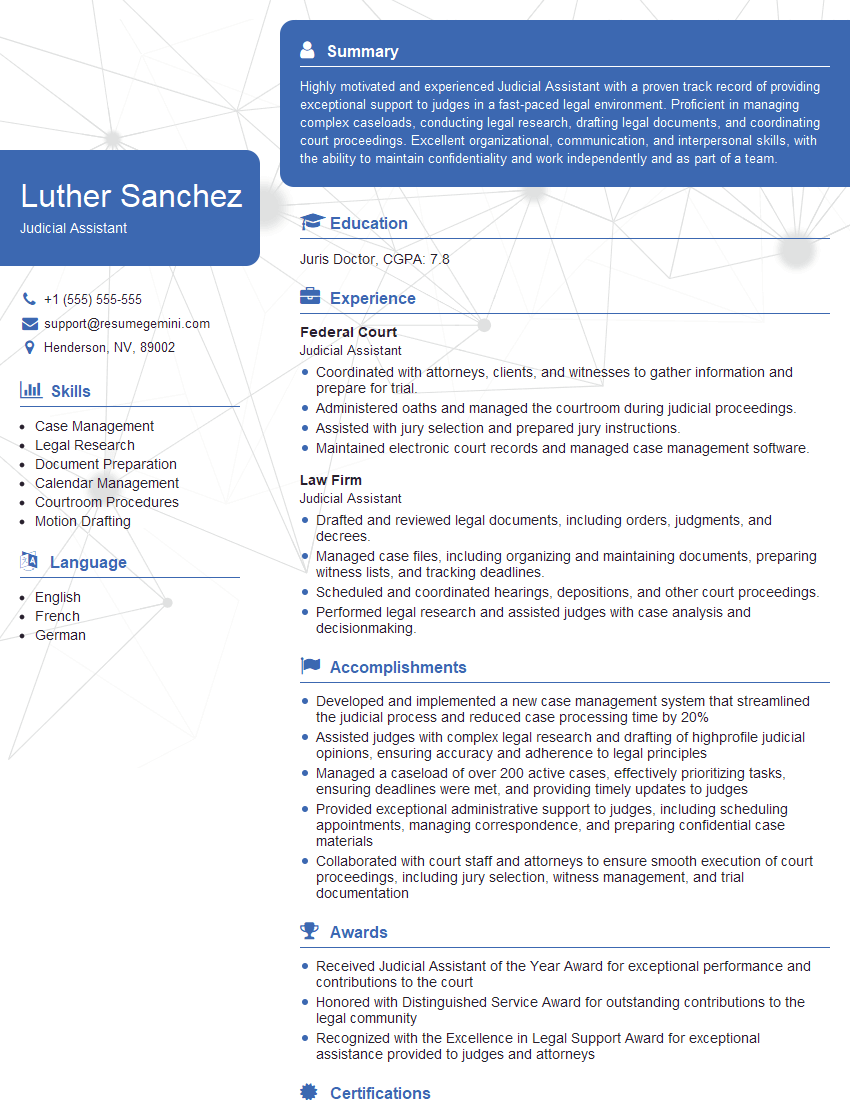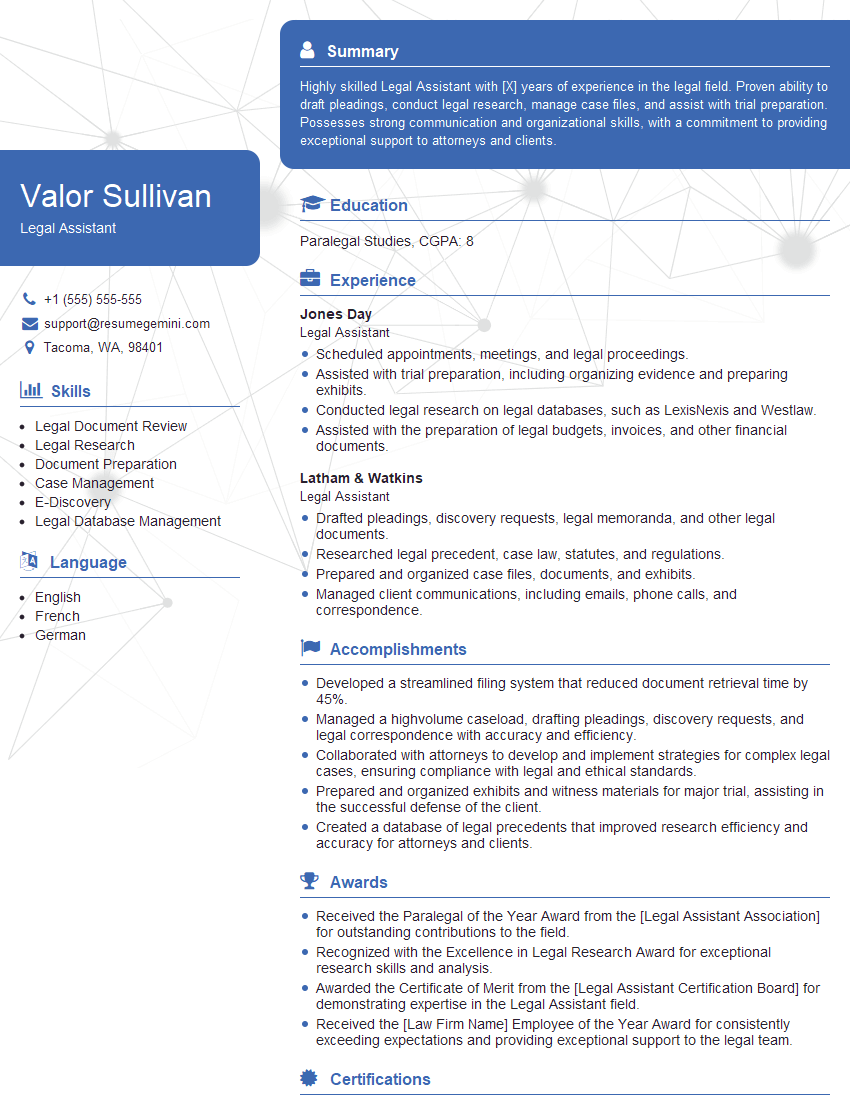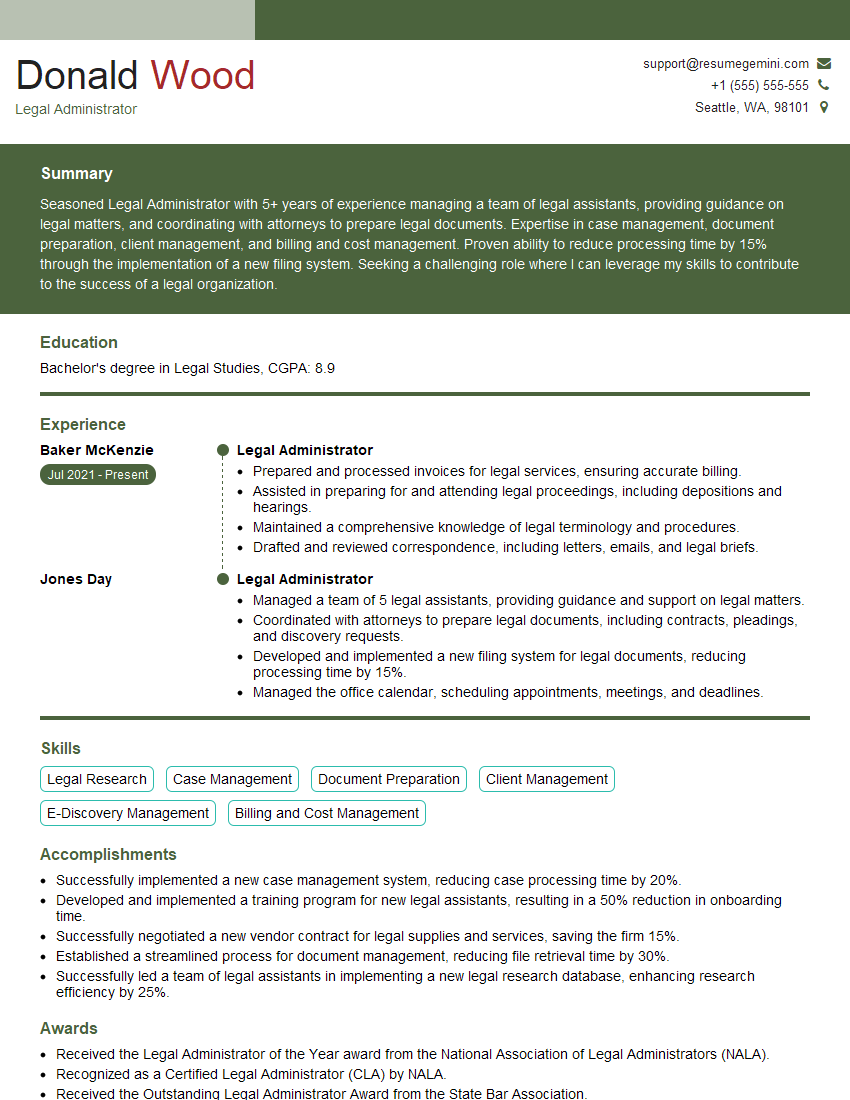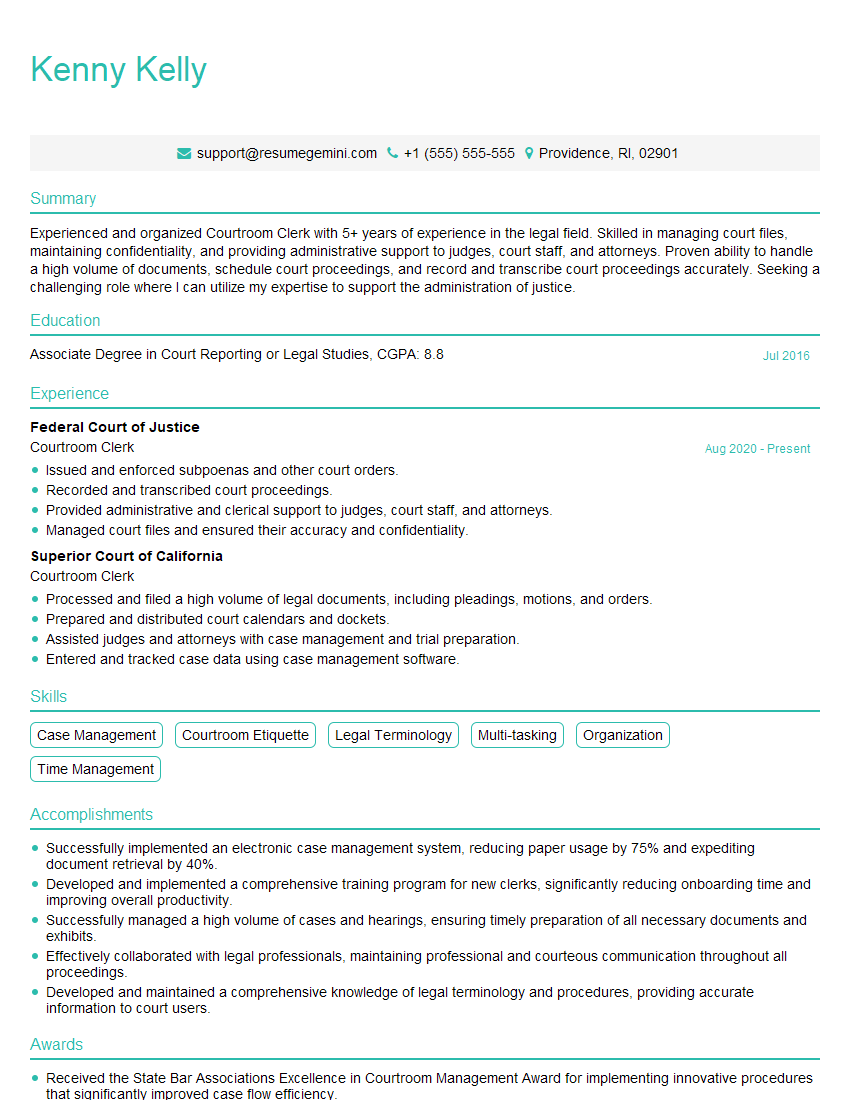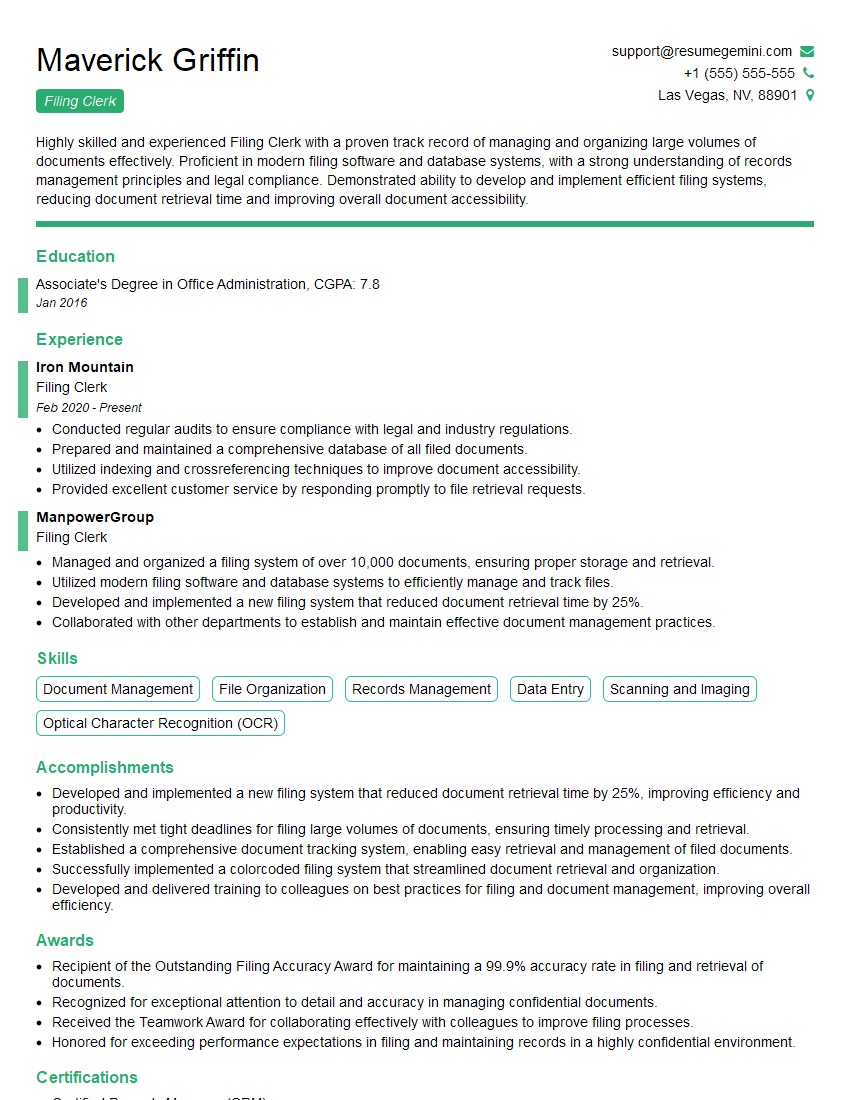Interviews are opportunities to demonstrate your expertise, and this guide is here to help you shine. Explore the essential Court Filing interview questions that employers frequently ask, paired with strategies for crafting responses that set you apart from the competition.
Questions Asked in Court Filing Interview
Q 1. Describe your experience with electronic court filing systems.
My experience with electronic court filing systems (ECFS) spans over eight years, encompassing various platforms like CM/ECF, Odyssey, and others. I’m proficient in navigating these systems, understanding their unique features, and troubleshooting common issues. This includes everything from initial account setup and document preparation to e-filing, tracking case progress, and managing electronic service. For instance, I’ve successfully utilized Odyssey’s features to efficiently manage multiple cases simultaneously, including complex multi-party litigation. I’m also adept at using ECFS to generate and submit various reports required by the court, including paying fees online.
My experience isn’t limited to simply using the software. I understand the implications of e-filing, including the technical requirements for document formatting, the importance of metadata accuracy, and the legal ramifications of improper e-filing practices. I’m also familiar with security protocols and data encryption practices related to ECFS.
Q 2. Explain the process of preparing and filing legal documents.
Preparing and filing legal documents involves a meticulous process, ensuring accuracy and compliance with court rules. It begins with a thorough understanding of the case facts, applicable laws, and the specific court’s rules of procedure. This understanding dictates which forms and documents are required and how they need to be formatted.
- Drafting the Documents: I utilize word-processing software with robust features, such as track changes and version control, to create well-organized and error-free documents. I pay close attention to formatting requirements, including font size, margins, and pagination, as stipulated by court rules.
- Review and Proofreading: Multiple layers of review are essential. This includes a self-review, a peer review (if applicable), and potentially a review by the attorney. Grammar and spelling are checked meticulously, and the document’s factual accuracy is confirmed.
- Compliance with Court Rules: Each court has specific rules regarding document formatting, filing fees, and service requirements. Adhering to these rules is crucial for avoiding delays and potential rejection of the filing. This includes confirming the correct number of copies, certificate of service information, and appropriate docket numbers.
- E-Filing (if applicable): The documents are uploaded to the relevant ECFS, ensuring all necessary metadata is accurately entered. I verify that the filing is complete and accurate before submitting it to avoid errors and potential delays.
- Tracking and Confirmation: After filing, I track the filing’s status through the ECFS to ensure it’s been accepted by the court and is ready for review by the judge and opposing parties.
For example, in a recent case, I meticulously prepared a motion for summary judgment, ensuring compliance with the local court’s specific page limits and citation format. This diligence prevented any delays or rejections, contributing to the case’s efficient progress.
Q 3. What are the different types of court filings you are familiar with?
I’m familiar with a wide range of court filings, including but not limited to:
- Complaints and Answers: Initiating lawsuits and responding to them.
- Motions: Requests for court orders, such as motions to dismiss, motions for summary judgment, and motions in limine.
- Pleadings: Formal statements of claims and defenses in a lawsuit.
- Discovery Documents: Interrogatories, requests for production of documents, and depositions.
- Briefs: Written arguments submitted to the court.
- Appeals: Documents filed to challenge lower court decisions.
- Notices and Stipulations: Formal communications between parties and the court.
- Affidavits and Declarations: Sworn statements of fact.
My experience encompasses handling both simple and complex filings, often involving multiple supporting exhibits and intricate legal arguments. I understand the nuances of each filing type and its implications within the broader context of litigation.
Q 4. How do you ensure the accuracy and completeness of court filings?
Ensuring accuracy and completeness is paramount. My approach involves a multi-step process:
- Multiple Proofreads: I meticulously review each document for grammatical errors, typos, factual inconsistencies, and compliance with court rules.
- Verification of Citations: All legal citations are carefully verified for accuracy and completeness, ensuring they support the arguments made in the document.
- Cross-referencing Documents: When multiple documents are involved, I cross-reference them to ensure consistency and avoid contradictions.
- Metadata Review: For electronic filings, I rigorously check metadata to ensure accuracy and completeness, including correct case numbers, parties’ names, and document descriptions.
- Checklist System: I use checklists specific to each filing type to ensure nothing is overlooked.
- Technology Utilization: Leveraging software tools for grammar, spell checking, and citation verification assists in maximizing accuracy.
For example, before submitting a complex motion, I meticulously check the supporting exhibits, ensuring that all are properly referenced and included. This rigorous process prevents errors and ensures that the filing is complete and accurate, contributing to efficient case management and preventing delays.
Q 5. What are the deadlines and consequences of missing filing deadlines?
Filing deadlines are strictly enforced. Missing a deadline can have serious consequences:
- Dismissal of Claims or Defenses: Failure to file timely can result in the dismissal of a case or specific claims.
- Default Judgments: If a defendant fails to respond within the deadline, the court can enter a default judgment against them.
- Sanctions: The court might impose sanctions on the party who missed the deadline, including monetary fines or other penalties.
- Loss of Rights: Missing deadlines can permanently prevent a party from exercising certain rights or presenting certain arguments.
- Negative Impact on Credibility: Repeatedly missing deadlines can damage a party’s credibility with the court.
I use a variety of methods to ensure deadlines are met, including calendar reminders, electronic alerts, and tracking systems. I proactively communicate with attorneys about approaching deadlines and any potential issues.
Q 6. How do you handle confidential information in court filings?
Handling confidential information requires strict adherence to ethical and legal obligations. My approach focuses on:
- Secure Storage: Confidential information is stored in password-protected electronic files and secure physical locations.
- Redaction and Anonymization: When necessary, I redact or anonymize sensitive information to comply with confidentiality requirements.
- Secure Transmission: Confidential documents are transmitted securely using encrypted email or secure file-sharing platforms.
- Compliance with Court Rules: I strictly adhere to court rules and legal standards concerning confidentiality, particularly in relation to protected health information (PHI), social security numbers (SSNs), and other sensitive data.
- Limited Access: Access to confidential information is limited to authorized personnel only.
For example, in cases involving sensitive personal information, I carefully redact irrelevant details before filing. I prioritize the protection of client confidentiality and ensure compliance with all applicable rules and regulations.
Q 7. Describe your experience with different court rules and procedures.
My experience encompasses working with diverse court rules and procedures across various jurisdictions. I am familiar with both federal and state court rules, recognizing their unique requirements. I understand the distinctions between different types of courts (e.g., district courts, appellate courts) and their respective rules of procedure. This includes:
- Rule 11 Sanctions: Understanding the requirements for certifying pleadings and avoiding potential sanctions for frivolous filings.
- Local Rules: Familiarity with the specific local rules of each court which govern filing procedures, deadlines, and formatting requirements.
- E-Filing Rules: Proficiency in navigating and complying with court-specific e-filing rules and regulations.
- Service of Process Rules: Understanding and complying with rules related to the proper service of legal documents on opposing parties.
My adaptability allows me to quickly learn and apply the specific rules of any court, ensuring that all filings meet the highest standards of accuracy and compliance. I have a keen understanding that any deviation from court rules can significantly impact the outcome of a case.
Q 8. How do you organize and manage large volumes of court documents?
Managing large volumes of court documents requires a robust, systematic approach. Think of it like organizing a massive library – you can’t just throw everything on the shelves haphazardly. My strategy involves a multi-pronged approach: First, I utilize a comprehensive electronic filing system, typically cloud-based for easy access and collaboration. This allows for efficient document storage and retrieval using keywords, case numbers, and client names. Second, I implement a strict folder structure, mirroring the court’s organization where possible, to ensure quick location of specific documents. For example, I might have folders for each case, subfolders for pleadings, motions, exhibits, and correspondence. Third, I employ robust metadata tagging – adding detailed descriptions and keywords to each document – making searches incredibly efficient. Finally, regular backups and data cleansing are crucial to maintain data integrity and prevent loss.
For instance, in a complex commercial litigation case with hundreds of documents, I’d use a system with version control to track amendments and revisions, ensuring I always submit the most up-to-date version. The metadata tagging would ensure that finding a specific expert report within that mass of documents is quick and easy, saving crucial time during deadlines.
Q 9. What software or tools are you proficient in for court filing?
My proficiency spans several software and tools commonly used in court filing. I’m highly adept at using electronic filing systems like CM/ECF (Case Management/Electronic Case Files), which are standard for many federal courts. I’m also familiar with various state-specific e-filing portals. Beyond e-filing, I’m proficient in document management software like Adobe Acrobat Pro, which allows for advanced redaction, annotation, and PDF creation/manipulation. I use Microsoft Office Suite extensively for creating documents, spreadsheets for managing case data (such as deadlines, filing fees, and contact information), and Outlook for scheduling and communication. Finally, I utilize cloud-based solutions like Dropbox and Google Drive for secure storage and seamless collaboration with colleagues and clients.
Q 10. How do you track the status of court filings?
Tracking the status of court filings is paramount to ensure timely responses and compliance with deadlines. I primarily rely on the court’s electronic case filing systems, which provide real-time updates on filings, including acceptance, docketing, and scheduling information. Many systems offer email notifications for key events. In addition, I maintain detailed spreadsheets or use dedicated case management software to log all filings, including filing dates, case numbers, and court confirmation numbers. This creates a comprehensive audit trail. For instances where the court system lacks robust online tracking, I regularly check the court’s website or contact the clerk’s office directly. Proactive monitoring prevents missed deadlines and potential negative consequences.
Imagine a situation where an urgent motion needs to be filed and a quick response from the court is necessary. My tracking system allows me to immediately identify whether the filing was successfully received and scheduled, allowing for prompt follow-up if necessary.
Q 11. Explain your experience with various filing fees and payment methods.
My experience with filing fees and payment methods is extensive, as it varies significantly based on jurisdiction, court type, and the nature of the filing. I understand that fees can range from relatively small amounts for simple filings to substantial sums for complex cases, including filing fees, service fees, and copying costs. I’m proficient in various payment methods, including online payments through court portals (often requiring credit card or e-check), cashier’s checks, money orders, and sometimes even personal checks. I always ensure that fees are paid accurately and on time to avoid any delays or penalties. Understanding the specific requirements of each court is critical to prevent rejection of filings and avoid extra costs associated with resubmission. For example, I’m aware that some courts might require a specific type of payment or a payment plan for indigent clients, and I take extra care to understand and follow those procedures.
Q 12. Describe your problem-solving skills when facing filing challenges.
Problem-solving is inherent in court filing. Challenges are inevitable. My approach involves a methodical process. First, I identify the problem. Is it a technical issue with the e-filing system? An unclear court rule? An incomplete document? Second, I research the issue, consulting court rules, online resources, and contacting the court clerk’s office when needed. Third, I develop potential solutions. This could range from correcting a document error to seeking clarification on a procedural rule or utilizing alternative filing methods. Finally, I implement the solution, meticulously documenting each step. For example, if a filing is rejected due to a technical error, I analyze the rejection reason, correct the issue, and re-submit the document. If a rule is unclear, I seek guidance from the clerk’s office to ensure compliance.
Q 13. How do you prioritize tasks when handling multiple court filings?
Prioritizing tasks when handling multiple court filings involves a strategic approach. I employ a system that combines urgency, deadlines, and potential consequences. I use a combination of tools such as project management software and color-coded calendars to prioritize filings based on approaching deadlines. Filings with strict deadlines or severe consequences for non-compliance take precedence. I also factor in the complexity of each filing; some filings might require more time and attention than others. Additionally, client needs and instructions are taken into account. My organizational skills, coupled with this strategic approach, enable me to manage multiple filings efficiently and minimize the risk of missed deadlines or errors.
Q 14. How familiar are you with different court jurisdictions and their filing requirements?
I possess a strong understanding of different court jurisdictions and their diverse filing requirements. I understand that rules vary considerably between state and federal courts and even within different courts of the same level. My familiarity includes knowledge of specific court rules regarding formatting, deadlines, and acceptable document types. For instance, the requirements for serving legal documents and the acceptable methods for electronic filing differ significantly between state and federal courts. I actively research and stay updated on these rules using various sources, such as court websites, legal databases, and continuing legal education materials. I understand that failing to comply with these requirements can lead to significant delays, and even dismissal of cases. As a result, accuracy and thoroughness are paramount to my work.
Q 15. How do you maintain a high level of accuracy and efficiency in your work?
Maintaining accuracy and efficiency in court filings is paramount. It’s a balancing act between meticulous attention to detail and streamlined processes. I achieve this through a multi-pronged approach:
- Structured Workflow: I utilize a highly structured workflow, employing checklists for each stage of the filing process, from initial document review to final submission. This minimizes the risk of overlooking crucial details.
- Technology Integration: I leverage technology to automate repetitive tasks like formatting and e-filing, freeing up time for more complex tasks requiring careful review. For example, I use software that automatically checks for compliance with local court rules regarding formatting and page numbering.
- Quality Control: A rigorous quality control system is integral to my process. This involves multiple reviews of every document—a preliminary check for completeness, a second check for accuracy, and finally, a final proofread before submission.
- Continuous Learning: Court rules and procedures constantly evolve. I actively engage in continuing legal education (CLE) to stay updated on changes and best practices, ensuring I always operate with the latest knowledge.
For instance, in a recent case involving a complex property dispute, my structured approach helped me identify a minor discrepancy in the property address that could have resulted in a significant delay. My diligent review ensured timely correction and prevented a potential setback.
Career Expert Tips:
- Ace those interviews! Prepare effectively by reviewing the Top 50 Most Common Interview Questions on ResumeGemini.
- Navigate your job search with confidence! Explore a wide range of Career Tips on ResumeGemini. Learn about common challenges and recommendations to overcome them.
- Craft the perfect resume! Master the Art of Resume Writing with ResumeGemini’s guide. Showcase your unique qualifications and achievements effectively.
- Don’t miss out on holiday savings! Build your dream resume with ResumeGemini’s ATS optimized templates.
Q 16. Describe your experience with managing deadlines and time constraints.
Managing deadlines is a critical skill in court filings. Missed deadlines have serious consequences, leading to sanctions or case dismissals. My approach to deadline management involves several key strategies:
- Detailed Calendaring: I maintain a meticulous calendar detailing all deadlines, including filing dates, response deadlines, and hearing dates. This calendar isn’t just a list; it incorporates buffer time to account for unexpected delays.
- Prioritization: I prioritize tasks based on urgency and importance, using a system that clearly identifies critical deadlines and tasks. This prevents urgent tasks from being overshadowed by less pressing ones.
- Proactive Communication: I proactively communicate with clients and court personnel about potential delays or challenges. Early communication is crucial to prevent minor issues from escalating into significant problems. This open communication also helps to build trust and rapport.
- Contingency Planning: For particularly tight deadlines, I develop contingency plans to account for potential roadblocks. This could involve preparing alternative filing methods or having backup documents ready.
In one instance, a last-minute change in court procedures threatened to delay a crucial filing. My contingency plan, already in place, allowed me to swiftly adapt and meet the new deadline without any disruption.
Q 17. How do you handle errors or discrepancies in court filings?
Handling errors or discrepancies in court filings requires immediate action and careful documentation. My process involves:
- Immediate Identification: I use a multi-layered review process to catch errors early. If an error is discovered, I immediately document it, noting the nature of the error, the date of discovery, and the steps taken to correct it.
- Prompt Correction: Depending on the nature of the error, I either correct it directly through an amended filing or formally notify the court and request permission to correct the error. This notification should include a clear explanation of the error and a copy of the corrected document.
- Transparency and Communication: I immediately inform the relevant parties, including my client and the court, about the error and the steps taken to remedy it. This shows responsibility and maintains transparency.
- Learning from Mistakes: After resolving the error, I analyze the situation to identify the root cause of the error and implement measures to prevent similar mistakes in the future. This might include refining the existing workflow or enhancing the quality control process.
For example, if a typographical error is found in an already filed document, I would file an amended document and inform the court and opposing counsel, ensuring that everyone is aware of the correction and its impact on the case.
Q 18. How do you ensure compliance with all relevant rules and regulations?
Compliance with court rules and regulations is non-negotiable. My approach to ensuring compliance involves:
- Thorough Research: Before any filing, I conduct thorough research of the relevant rules and regulations of the specific court. This often involves consulting the court’s website for local rules, as well as relevant statutes and case law.
- Strict Adherence: I meticulously follow all filing requirements, paying close attention to details like formatting, page limits, and deadlines. This includes verifying all necessary supporting documents are included and accurately referenced.
- Regular Updates: I stay informed about any changes or updates to court rules and regulations through continuing legal education and official court publications.
- Utilizing Court Resources: I leverage the resources provided by the court, including online guides, FAQs, and contact information for court personnel, to address any ambiguities or questions.
For instance, understanding the specific requirements for electronic filing in a particular jurisdiction is crucial and prevents delays or rejections of documents.
Q 19. What is your experience with managing court filing deadlines under pressure?
Managing court filing deadlines under pressure is a regular occurrence. My experience has taught me the importance of remaining calm, organized, and resourceful under pressure. My strategies include:
- Prioritization and Delegation: I prioritize tasks effectively and delegate responsibilities when feasible, ensuring that crucial tasks are completed on time.
- Time Management Techniques: I utilize time management techniques such as the Pomodoro Technique or time blocking to maintain focus and avoid burnout.
- Stress Management: I employ stress management strategies, such as regular breaks and mindfulness techniques, to maintain focus and clarity when faced with tight deadlines.
- Seeking Assistance: When necessary, I seek assistance from colleagues or supervisors to ensure timely completion of critical tasks.
In a high-pressure situation involving a motion for summary judgment with a very short deadline, I successfully prioritized the key arguments, efficiently delegated research tasks, and worked extended hours to ensure timely and successful filing. This meticulous planning and resilience averted a potential negative outcome.
Q 20. How do you communicate effectively with judges, clerks, and other court personnel?
Effective communication with judges, clerks, and other court personnel is crucial for smooth and efficient case processing. My approach emphasizes:
- Professionalism and Courtesy: I always maintain a professional and courteous demeanor, regardless of the circumstances. Clear, concise, and respectful communication is key.
- Clarity and Conciseness: I ensure my communication is clear, concise, and easy to understand. Avoiding legal jargon where possible makes my communications accessible to everyone.
- Active Listening: I actively listen to understand the concerns or instructions of the judge, clerk, or other personnel, ensuring I address their points accurately.
- Prompt Responses: I respond promptly to inquiries and requests, acknowledging receipt of messages and providing timely updates.
For example, if a clerk requests additional information or clarification, I respond quickly and provide the necessary details in a clear, organized manner to expedite the process.
Q 21. Describe your experience with using case management software.
I have extensive experience using various case management software, including [mention specific software examples, e.g., CaseText, Clio, MyCase]. These tools are essential for organizing case documents, tracking deadlines, and managing communications. My experience encompasses:
- Document Management: I utilize these software platforms for secure document storage, organization, and retrieval, ensuring easy access to case-related materials.
- Deadline Tracking: I leverage the integrated calendar and reminder functions to track deadlines, ensuring prompt filings and responses.
- Communication Management: The communication tools within these platforms enable efficient interaction with clients and court personnel, maintaining a clear record of all communication.
- Reporting and Analytics: I use the reporting functionalities to track case progress, identify potential bottlenecks, and generate performance reports.
In a recent case, the software’s automated reminder system alerted me to an upcoming deadline, preventing a potential missed filing. The ability to easily access and share documents through the platform also significantly streamlined communication with the client and the opposing counsel.
Q 22. How do you stay up-to-date on changes in court rules and procedures?
Staying current with ever-evolving court rules and procedures is paramount for effective court filing. I employ a multi-pronged approach. Firstly, I subscribe to legal news services and professional journals that regularly update on procedural changes in relevant jurisdictions. Secondly, I actively participate in continuing legal education (CLE) courses and webinars specifically focused on court procedures and rules. These often cover recent case law interpretations that impact filing practices. Thirdly, I maintain a network of colleagues and professionals within the legal field, engaging in regular discussions and knowledge sharing to stay informed about changes that may not be widely publicized. Finally, I diligently check the official websites of the courts I regularly work with, as they are usually the primary source for updates to their local rules. This multifaceted strategy ensures I remain consistently informed and prepared for any procedural shifts.
Q 23. Describe a time you had to deal with a difficult or challenging court filing.
One particularly challenging filing involved a complex class-action lawsuit with a tight deadline. The plaintiff’s filing was voluminous, containing thousands of pages of documents, many of which required careful review for privilege and redaction before submission. Complicating matters further, the court had recently implemented new e-filing requirements that were not yet fully documented. We faced the dual pressure of meeting the deadline and navigating these new rules. My team and I used a project management approach, meticulously dividing the documents among ourselves for review and redaction. We also proactively contacted the court clerk’s office for clarification on the new e-filing system, and discovered that they were still working on a FAQ and some of the online instructions were outdated. We used this opportunity to establish a clear communication channel, regularly providing updates to ensure our filing was in line with their expectations. Through proactive communication and diligent teamwork, we successfully submitted the filing on time and in compliance with all regulations. This experience highlighted the importance of thorough preparation, robust project management, and proactive communication with the court.
Q 24. How do you maintain confidentiality in a court filing environment?
Maintaining confidentiality in court filings is paramount. My approach is multifaceted. First, I ensure all documents are handled with care, limiting access only to authorized personnel. This includes physically securing documents in locked cabinets and electronically protecting them through password protection and encryption. Second, I adhere strictly to all court-ordered protective orders and confidentiality agreements. Any sensitive information needing redaction is meticulously removed according to established protocols. Thirdly, I am conscious about using secure methods for electronic communication, especially when transferring files containing confidential data. Fourthly, I regularly review and update our firm’s security policies and protocols to ensure our practices remain aligned with best-practice standards. For example, we use secure file-sharing platforms and regularly update our anti-virus software. This commitment to secure handling and transmission prevents unauthorized access and maintains the integrity of client confidentiality.
Q 25. How familiar are you with the rules of evidence relevant to court filings?
I possess a thorough understanding of the rules of evidence. This knowledge is critical in ensuring the admissibility of submitted documents. I am familiar with various evidentiary concepts, such as relevance, hearsay, authentication, best evidence, and privilege. For instance, I understand the distinctions between different types of hearsay exceptions and can identify documents that would likely be deemed inadmissible due to such issues. My experience includes preparing and reviewing documents to ensure they meet evidentiary standards before filing. This includes properly authenticating documents, providing proper foundation for admission, and ensuring compliance with rules regarding privileges (such as attorney-client privilege or doctor-patient privilege). This understanding allows me to proactively identify potential evidentiary problems and help ensure the successful presentation of cases by identifying potential issues during document review and preparing the client for evidentiary challenges at trial.
Q 26. What steps do you take to ensure successful e-filing of documents?
Successful e-filing requires careful preparation and attention to detail. I begin by verifying the court’s specific e-filing requirements and technical specifications. This usually includes checking for compatible file formats, size limitations, and any required metadata. I then prepare the documents using the correct format and name conventions. Prior to actual submission, I always perform a thorough review of the documents to ensure accuracy and completeness. It is critical to meticulously check for any errors such as typos, missing pages, or incorrect metadata, as these can lead to rejection. During the e-filing process, I follow the court’s online instructions precisely and double-check the submission confirmation. I also keep records of all submitted documents and associated confirmation numbers. Finally, I follow up on the submission to ensure that the court has received and properly processed the filed documents. A systematic approach, thorough document review, and careful attention to detail ensures a smoother and more efficient filing process. This minimizes the risk of rejection or delays due to technical issues.
Q 27. How do you handle document redaction and confidentiality in court filings?
Document redaction and confidentiality are handled with extreme diligence. I use specialized software designed for redaction, ensuring the removal of sensitive information is complete and irreversible. This software allows for precise control, creating audit trails that document every redaction made. I follow court-specific rules and guidelines regarding redaction and ensure all redacted documents maintain the integrity of the original document while protecting sensitive data. This includes using a method that is clear, consistent, and readily apparent upon review. We often employ the use of metadata removal tools as well to further enhance security. Following a strict protocol for redaction and the use of verified software mitigates the risks of accidental disclosure of confidential material and ensures compliance with the rules and requirements of each court.
Q 28. Describe your experience with preparing and filing appellate briefs.
My experience with appellate briefs encompasses all stages, from initial research and legal analysis to drafting, editing, and final filing. I am adept at organizing and structuring briefs to clearly and concisely present arguments, focusing on relevant case law and legal precedents. This includes meticulous citation checking and formatting to ensure compliance with the specific court’s rules and formatting requirements. I understand the importance of crafting compelling narratives and persuasive arguments that persuasively advance the client’s position. Furthermore, I am proficient in responding to opposing briefs, identifying weaknesses and constructing counter-arguments effectively. I have a strong understanding of appellate procedure, from jurisdictional issues to the rules governing oral arguments, ensuring all aspects of the process are thoroughly addressed. My role includes providing comprehensive support to the legal team, from conducting factual and legal research to collaborating on the strategy and development of the appeal.
Key Topics to Learn for Court Filing Interview
- Understanding Court Procedures: Comprehending the various stages of the court filing process, from initial submission to final disposition. This includes understanding deadlines and potential consequences of missed deadlines.
- Legal Document Preparation: Mastering the skills needed to prepare accurate, complete, and legally compliant court documents. This involves understanding different document types and formatting requirements.
- Electronic Filing Systems (eFiling): Gaining proficiency in using electronic filing systems, including understanding their specific requirements and troubleshooting common technical issues. This includes familiarity with various eFiling platforms.
- Case Management Systems (CMS): Familiarity with different Case Management Systems used by courts to track case progress and manage documents. Understanding how to navigate and utilize these systems efficiently.
- Rules of Civil Procedure and Evidence: A foundational understanding of relevant rules and procedures that govern the court filing process. This ensures compliance and efficient document preparation.
- Data Entry and Verification: Developing meticulous attention to detail in accurately entering and verifying data within court systems. This minimizes errors and ensures data integrity.
- Organization and Time Management: Practicing effective organization and time management skills to handle multiple cases and meet tight deadlines in a high-pressure environment.
- Problem-Solving and Troubleshooting: Developing the ability to identify and resolve issues that arise during the court filing process, including technical difficulties or procedural complexities.
- Legal Terminology and Research: Demonstrating a strong understanding of legal terminology and the ability to conduct effective legal research to support filing processes.
- Client Communication and Confidentiality: Understanding the importance of maintaining client confidentiality and communicating effectively with clients, judges, and court staff.
Next Steps
Mastering court filing skills opens doors to a rewarding career in the legal field, offering opportunities for growth and advancement. A well-crafted, ATS-friendly resume is crucial for showcasing your qualifications to potential employers. To significantly boost your job prospects, consider using ResumeGemini to create a professional and impactful resume tailored to the specific requirements of Court Filing positions. ResumeGemini provides valuable tools and examples to help you craft a winning resume. Examples of resumes tailored to Court Filing are available below.
Explore more articles
Users Rating of Our Blogs
Share Your Experience
We value your feedback! Please rate our content and share your thoughts (optional).
What Readers Say About Our Blog
Hi, I’m Jay, we have a few potential clients that are interested in your services, thought you might be a good fit. I’d love to talk about the details, when do you have time to talk?
Best,
Jay
Founder | CEO
